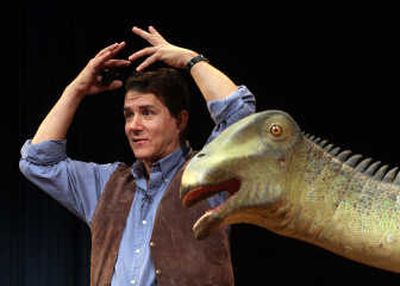Paleontologist unveils ‘cow of the Mesozoic’

WASHINGTON – Could an elephant-sized dinosaur with a skull so thin that a karate chop would have split it in two, teeth that only lasted a month, and a brain that, yes, was the size of a walnut, ever be considered one of evolution’s success stories?
Paul Sereno thinks so. The University of Chicago paleontologist on Thursday unveiled Nigersaurus taqueti, a strange creature that is helping rewrite theories about what long-necked, plant-eating dinosaurs looked like and how they behaved.
Nigersaurus appears to have spent a lifetime with its head in a hang-dog position. Using a broad, tooth-filled mouth, it grazed on ferns and horsetails growing at most a couple of feet off the ground. It couldn’t even hold its head horizontal; getting leaves off trees was out of the question.
Many other dinosaurs – including the more famous and less bizarre Diplodocus – probably behaved similarly, using their long necks as ground-mowing booms, not tree-top cherry-pickers, Sereno believes.
“It took an extreme dinosaur to open our eyes to this cow-like behavior,” he said Thursday at the National Geographic Society’s headquarters in Washington, where a reconstruction of Nigersaurus was mounted. “It is sort of silly to think that something wasn’t doing this. But we had missed the cows of the Mesozoic.”
Other paleontologists agreed the new dinosaur will further dispel the notion that long-necked dinosaurs were the prehistoric equivalent of giraffes, holding their heads high overhead.
“It would be hard to imagine a more compelling argument against” that view, said Kent Stevens, a computer scientist at the University of Oregon who has done extensive research on dinosaur posture.
Matthew Carrano, the curator of dinosaurs at the Smithsonian Institution, doubts the announcement of a bovine dinosaur will be viewed with much skepticism. There have been too many other strange-but-true discoveries in recent years.
Nigersaurus, was discovered in the Sahara in the northwest African country of Niger in 1997 by Sereno, who is also an explorer in residence at the National Geographic Society.
It was excavated over three years by a large team that included two paleontologists from the University of Niamey, in Niger, who attended Thursday’s unveiling of a life-size model. Parts of five skeletons were found, including one that was 80 percent complete.
The dinosaur has several physical features that are extreme versions of adaptations seen in other grazing animals.
For example, many grazers have broad faces and prominent teeth at the front of the jaw so that they can take in large amounts of food with each bite. This is necessary because grass and other ground cover is low in nutritional value.
Nigersaurus’ mouth is wider than its skull – a bit like a hammerhead shark’s – and is the only terrestrial animal with that feature. Furthermore, all of its teeth are incisors, lined up to form a single clipping mechanism just under its lips.